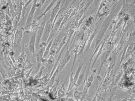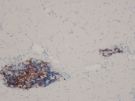HypOrth/EU

Research Focus
 Osteoblasts primary culture
Osteoblasts primary culture
 Immunoreactivity CD 20 (B cells),10x
Immunoreactivity CD 20 (B cells),10x
Hypersensitivity reaction in metal-on-metal bearing coupling of hip endoprostheses.
In Germany, almost 200,000 hip joints are implanted per year, and within the first 15 years about 10% of the implants have to be replaced due to aseptic prosthesis loosening. A major cause of aseptic prosthesis loosening is bone loss due to the biological effect of abrasion particles from metal implants. These result from electrochemical abrasion or even corrosion. It can be assumed that a large part of the immune reactions to abrasion particles are of a non-specific nature, which show large individual differences. In addition to the involvement of the innate immune system to metal implants, specific T-cell mediated immune responses have been observed (Willert et al, 2005). In our group, the presence of different immune cell markers after aseptic prosthesis loosening is investigated, including staining with CD3 (T-lymphocytes), CD20 (B-lymphocytes) CD68 (macrophages) and CD11c (dendritic cells) or different inflammatory parameters such as TNFa and IL-17. In addition, the metal content in the tissue is measured in cooperation with the University of Applied Sciences Magdeburg-Stendal. The exact mechanisms involved in an allergic reaction to metals are largely unknown. Therefore, in vitro experiments with bone cell lines and with co-cultures of primary cells will help to better understand these relationships. (publication on this)
 Biofilm Staphylococcus aureus
Biofilm Staphylococcus aureus
Biofilm abrasion of bacteria-populated implants using ultrasound
Of the approximately 350,000 artificial hip and knee joints implanted in Germany each year, postoperative infection occurs in about 4,000 patients. Gram-positive germs are usually detectable in the infected peri-prosthetic tissue, with coagulase-negative staphylococci followed by Staphylococcus aureus and streptococci representing the most common pathogens at approximately 80 percent. These bacteria form a biofilm adhering to the denture surface, in which they communicate and multiply in a confined space in a hydrated extracellular matrix. The formation of a biofilm leads to a thousand-fold increase in resistance to proliferation-dependent antimicrobial agents. While debridement and irrigation, including antibiotic administration, can be performed in relatively mild symptomatic cases. In most circumstances, however, it will be followed by endoprosthesis replacement. A removal of the biofilm, which would save a prosthesis change, is the subject of our project, in which implants are incubated specifically with the biofilm-forming agent Staphylococcus epidermidis. Using different ultrasound frequencies, the strength of the detachment of the bacterial film will be investigated. In addition, the effect of ultrasound on the trabecular structure of the bone will be assessed using specific histological techniques such as Safranin Orange/Light Green and Masson-Goldner Trichrome staining.
Press Releases
2013-08-21 - HypORTH-Projekt startet - Pressemitteilung Universitätsklinikum
2013-08-27 - Neues Verbundprojekt zu Hüft-und Knieendoprothesen in Magdeburg - Ärzteblatt






